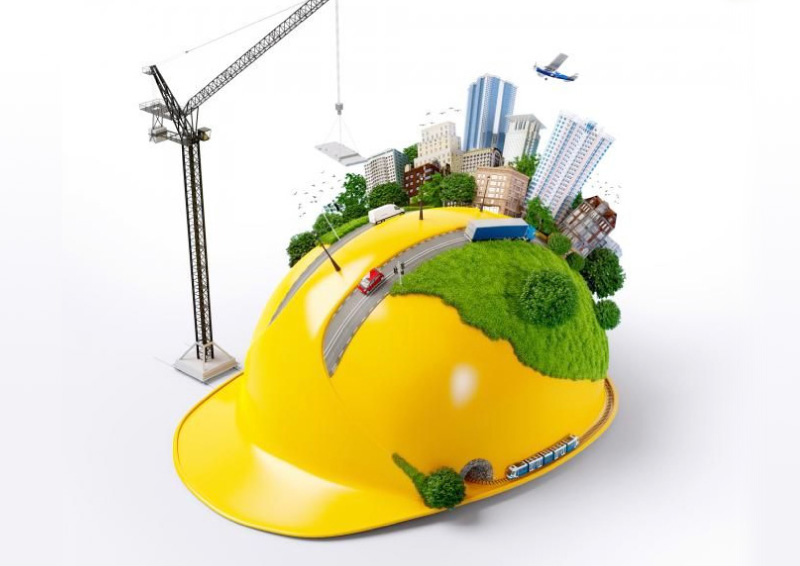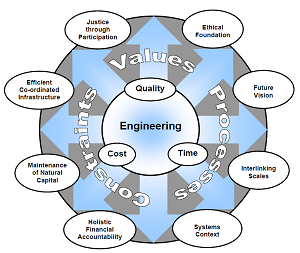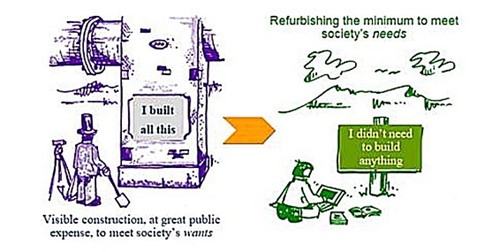Richard Fenner, Professor of Engineering Sustainability at Cambridge University’s Engineering Department and the co-author of Sustainable Infrastructure: Principles into Practice, explores progress towards sustainability in the UK construction sector.

- Updated: 24 Aug 2020
- Author: Richard Fenner
Current challenges
There have been many reports warning of the critical dangers facing the planet. These include the climate emergency, huge losses of biodiversity through unprecedented rates of species extinction, a global water crisis, increased hazards from extreme events and mass population movements, leading to rapid urbanisation.
What progress has been made in the civil engineering sector?
Progress towards achieving the Sustainable Development Goals by 2030 is slow and calls were made earlier this year for efforts to accelerate. They now have to be achieved against the huge difficulties brought about by the current global pandemic.

Figure 1: A sustainable framework for engineers
Fenner, R.A., Ainger C., Cruickshank H., Guthrie P, (2006)
In 2006 we published a sustainable framework for engineers (Figure 1). This attempted to address the complexity of sustainability through a series of practical questions which encouraged engineers to reflect on the sustainability of their actions and choices through all stages of project implementation. What was seen as urgent in 2006 is now becoming critical. It is therefore timely to revisit the 8 key areas identified in the framework to assess what progress has been made in the civil engineering sector.
The results of our review have recently been published in Civil Engineering, where we set out why much more commitment to working within sustainability constraints is needed, so that progress towards key targets can be achieved.
Improvements made so far
Of course, there have been significant steps forward in the last decade in assessment methods, systems thinking, multi-functional infrastructure, flexible and adaptive design, and the adoption of a circular economy in construction. However, whilst we found responses to the sustainability challenge are accelerating, with many examples of good practice from across the industry, much more needs to be done to go beyond just maintaining business-as-usual.
Remaining challenges
Significant issues remain regarding the ethical standards in relation to Client briefs, following wider social well-being goals as core drivers for infrastructure, maximising opportunities with regards to natural capital and leveraging a system-of-systems approach to infrastructure provision. However perhaps the biggest challenge is how to second guess such a rapidly changing and uncertain future in which civil engineers must only build what is unavoidably necessary, within an ever-tightening residual carbon-dioxide budget and increasingly restricted resource limits.
Engineering Sustainability Journal
Two themes have emerged from considering the papers published in ICE’s Engineering Sustainability journal between 2007 and 2019. First, much of the debate and innovation has been driven by energy and climate considerations, with wider sustainability themes, such as resource conservation and human social needs receiving less attention. Secondly, specific problems are frequently explored within a narrow system boundary, with the remit on maintaining performance within normal parameters, where concepts of sustainability are sometimes interpreted as simple durability. Compared to other sectors, the case for adopting strategic sustainability in civil engineering is considered complex as there are no standard production processes in which to minimise waste, or new product lines to feature reduced embodied energy. Infrastructure projects are widely different in character, scale and location. What is required is asking the right questions. Ones which often challenge orthodox ways of working and may necessitate changing the overall goals of the system.
Considerations for sustainable infrastructure
Infrastructure has a pernicious effect in which, once built, it locks in patterns of energy use, carbon dioxide emissions and individual behaviour. It is therefore so much cheaper to build in radical new standards at the start than to have to retrofit them afterwards. Deciding whether to build, and what, is critical. But using the traditional “predict and provide” and often incremental approach, with long gestation times, is challenged by the rapidity with which new data and research is produced.
It appears that civil engineers are only slowly changing from what is essentially a business-as-usual and often fragmented approach, reflecting the structure of the sector. There is a real dilemma that if the necessity of zero carbon is accepted for all projects, how can civil engineers continue current practice without accepting the need for radical change?
Positive signs
The Court of Appeal’s recent decision to outlaw Heathrow Airport’s third runway plan for failing to consider the government’s climate change commitments under the 2016 Paris Agreement to cut carbon emissions has rocked growth plans in the wider UK infrastructure sectors (NCE).
There are signs that others in the industry are recognising the urgency with which the issues raised here need to be addressed. For example, the National Federation of Builders have called for a radical change to construction, highlighting that the industry must be transformed within a generation, requiring a real step change in the way the construction industry does business, and warning that if construction companies do not respond they risk finding themselves left behind in a rapidly changing landscape, with action particularly on achieving low carbon becoming business critical.

Figure 2: A change in civil engineering culture could be the solution
Fenner, R.A., Ainger C. (2020)
Our book on the topic
Many of these issues are addressed in our (with co-author Charles Ainger) book Sustainable Infrastructure: Principles into Practice, available in print and as an eBook. It explores how a common set of sustainability principles can be applied to all types of infrastructure at each stage of a project’s delivery, from planning and development through to the implementation, in-use and end of life phases. The book shows how a change of approach is possible where the preferred option is first to manage demand and the last resort is to build a large project. This will be uncomfortable for many as it challenges ingrained aspects of civil engineering culture from which much professional satisfaction has come (Figure 2). The intention is to focus on “what engineers can do” and encourage all engineers to question every decision by asking individually: “Am I being sustainable?” and collectively “Are we doing enough?”.
Sustainable Infrastructure: Principles into Practice, available in print and as an eBook.
